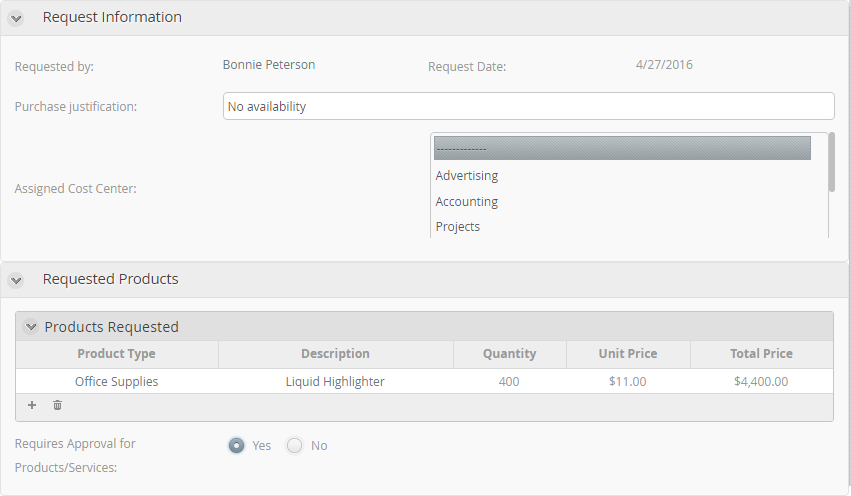Use
The List control lists all values of a specific entity. It allows for only one choice.
Considerations
Always give the list a Display attribute.
Related to attribute types
Lists are usually related to Parameter entities, as related attributes.
However they can also be related to Master entities and System entities. Take great care when relating lists to a Master entity; remember they hold all information pertaining to the case and thus they tend to increase in size. Displaying a very large list of values might become impractical for end users.
Properties
Every control has a set of properties that allow to customize its behavior in the Work Portal. However, some properties are exclusive to a specific control. The following are properties exclusive to the List control:
Basic tab
PROPERTY |
DESCRIPTION |
|---|---|
Display attribute |
Defines the attribute of the entity for display in the Work Portal. For example, the City entity has three attributes namely City name, City Area code and City initials. In order for the end user to easily recognize the City, the Display Attribute can be set to City name. |
Additional attribute |
Defines an additional attribute to be shown in the list. It will follow the Display attribute with a dash character. |
Display attribute and Additional attribute example

Advanced tab
PROPERTY |
DESCRIPTION |
|---|---|
Automatically sets a value when the form opens for the first time. As soon as a value is chosen by the user the default will be replaced. If the associated attribute is valued by means of an expression, the default value of the control will be ignored. The default value can also be set using an expression. |
|
Submit on change |
This property is deprecated. We suggest using Actions and Validations. When enabled, as the end user selects a value from the control, the entire form will refresh and execute all Actions, Validations and visibility rules, saving what has been entered. |
Sort by attribute |
Enables the List to be sorted by an attribute of the Parameter entity. The list in the child attribute is sorted in ascending order based on the chosen attribute. For example the Delivery City control can be sorted by either the City name or by Country code. If a method of sorting is not defined, the attribute will be ordered by its internal identifier. |
Allows you to define a smaller set of values, from the list of all possible values in the related entity, for displayed in your List control. Bizagi only displays the records that meet the filter condition defined in a Boolean expression. |
|
Clicking the Set to default value icon will reset the properties. |
Sort by example

Example
In a Purchase Request Process it is necessary to allocate the purchase cost to a Cost Center.
A Cost Center List control must be added for the end user to select the relevant center on the request Activity.
1. You need a Parameter entity containing all the Cost Centers belonging to the company. An attribute in the Process Entity must point to the Parameter entity; this will be done using a related attribute relationship between Purchase Request (Process Entity) and Cost Center (Parameter entity).

2. Add values (or records) to the Cost Center entity.
3. Drag and drop a List control, from the Controls tab, onto the form

4. In the Basic tab of the control's Properties locate the Data Source property.

5. Select the attribute path, that is, the entity from which the values for the list will be taken. In this case it will be the Cost Center entity.

6. Select the Display attribute. In this example it will be Cost Center.

7. Change the default data source's display name if it is required.

8. Add any other controls you need to the form and save it.
Go to the Work portal and test the control.

Last Updated 1/6/2022 11:26:16 AM